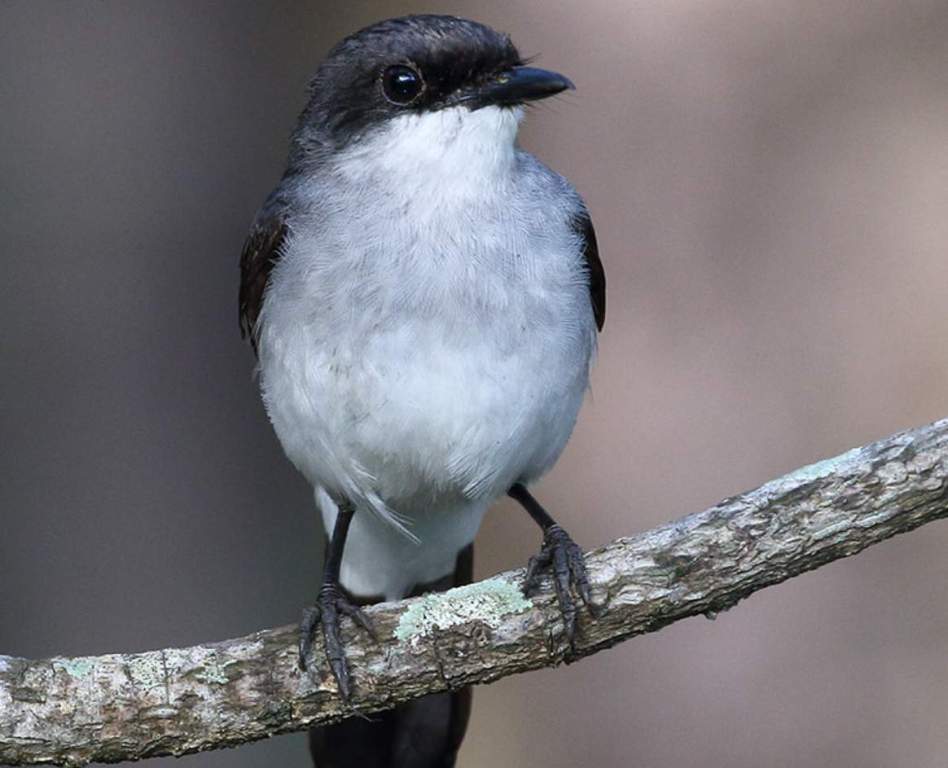Habitat: Mangrove Robin (Peneothello pulverulenta) lives primarily in mangroves along the coast and estuaries of northern Australia, where it prefers the denser, lower, mallee-like trees of Avicennia and Ceriops rather than the taller trees of Rhizophora and Brugiera. Typically, they are sedentary, living in pairs and family groups of six or eight year-round in a small territory. Foraging takes place at about half-two meters above the mud level in the mid-stage of mangroves.
As they glide silently between perches – on bare horizontal and vertical branches – they pause to watch and wait, their wings or tails occasionally flicking, before diving down on prey among stilt roots or on the mud surface. Robins have more rounded wings and tails than other robins, which makes them more maneuverable in tight mangrove thickets.
During breeding, they cling to mangrove trunks, probing bark; they hop along the surface of the mud and pick and probe with their Jong bill. Local groups display communally by chasing one another, drooping and fluttering their wings, singing, and fanning their tails while concealing their white sidebars. Females build and incubate nests without assistance, but both sexes feed the young.

CALL: Soft, plaintive, drawn-out one- or two-note whistle on one pitch, by both sexes for contact.
SONG: Harsh, repeated chuck by a male in alarm or territorial advertisement. Also a varied whistled song by male.
Diet: Mangrove Robins eat mangrove mud for food. It feeds on small crustaceans and insects such as beetles, ants, and wasps. Despite consuming mostly these prey items, the mangrove robin also consumes significant amounts of crabs.
Identification: Both sexes are similar; however the male bird is slightly larger. Upper parts mid to dark slate-grey; lores and rump black. Wings dark ash-brown, with a concealed dull white bar through the base of flight feathers showing in flight. Tail black, with basal half white, except for two central feathers. Underwing coverts black. Underparts white with breast-washed smoky grey. Eye dark brown. Bill and feel black, dark grey, or sepia. The immature is duller, molting from juvenile plumage in one-two months off. edging. Juveniles mid-brown above, coarsely mauled and streaked cream, buff-white below, coarsely mauled with brown over the breast, with pale mouth streak. Feet flesh-grey.
Nest & Breed: Nesting and breeding take place in August-May, mainly September-March. Nest small, shallow cup of thin bark strips interwoven with cobweb, decorated with green lichen; lined with wiry fibers and rootlets; usually in mangrove fork, often against the trunk, 1-4 m above the mud.
Eggs: This robin normally lays two or three eggs; lustrous, pale olive-brown, green or yellow-green, marked with blotches and spots of various reds and browns, with underlying slate-grey, usually forming zone towards the larger end; rounded-oval, about 19 x 15 mm. Incubation period is probably 15-16 days, for females.
Distribution: Mangrove Robin is mostly found in about Point Cloates, WA, along the northern coast lo Proserpine, Qld. Locally common but patchy and absent from Eighty Mile Beach. Also in the Aru Islands and New Guinea.
Races: There are two or three races; at least two in Australia.
Family: The mangrove robin belongs to the family Petroicidae.
Alternative Names: This bird is also known as Ashy Robin, Mangrove Shrike-robin, and White-tailed Robin.
Size: The Mangrove Robin size is about 150-160 mm long with an average weight of 21.3 grams.
Read More – Grey-headed Robin (Heteromyias cinereifrons)







